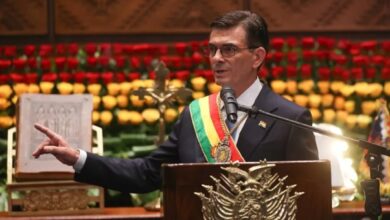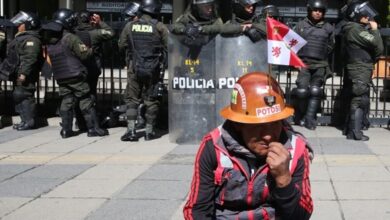The Arce Government says that Bolivian foreign trade has an “excellent performance”
Despite a 21.3% drop in exports from January to October 2023, the Bolivian government maintains that the country's foreign trade maintains an "excellent performance" compared to the previous eight years, exceeding average levels of exports by 20%.

12/12/2023.- The Bolivian Vice Minister of Foreign Trade, Benjamín Blanco, speaks during a press conference at the Bolivian Foreign Ministry, in La Paz (Bolivia). EFE/Luis Gandarillas
EFE
Listen to this article
Leer en español: El Gobierno de Arce dice que el comercio exterior boliviano tiene un “excelente desempeño”
The government of Luis Arce highlights the performance of Bolivian foreign trade amid challenges
The Government of Luis Arce defended this Wednesday that Bolivia's foreign trade maintains an "excellent performance" compared to the average of the previous eight years, despite the trade deficit and the 21.3% decrease in exports from January to October 2023. compared to the same period in 2022.
"This year, from January to October, Bolivia has export levels that exceed by 20% the exports that have been made in the last eight years, which shows that we are performing excellently," the Vice Minister of Commerce told the media. Exterior, Benjamín Blanco.
According to Blanco, the average value exported from January to October in the last eight years was approximately 7,000 million dollars and in the first ten months of 2023, Bolivian sales abroad reached 9,313 million dollars.
"That means that we are well above the average of recent years in exports," he insisted.
Comparison with Previous Years and Export Context
The vice minister acknowledged that, although the value exported this year is lower than the 11,836 million dollars reported in the same period last year, "this is because 2022 has been the year with the highest exports the country has recorded in its entire history."
He highlighted that the level exported as of October 2023 is above, for example, the 7,458 million dollars registered in the same period of 2019 or the 5,510 million in 2020.
Blanco also considered that the trade deficit of 177 million dollars "is a fairly small value in relation to the deficits" of 2015, 2016, or 2017, and assured that it is explained by the increase in imports of capital goods that, according to, is a sign that "the country is industrializing."
Value added
He also mentioned the change that the structure of exports has had in recent years, since in 2014, when the value of Bolivian sales abroad between January and October reached 11,157 million dollars, 51% of what was exported were hydrocarbons.
"At this moment, 52% of what we export, that is, 4,809 million dollars, are manufactured goods," he stated.
Agriculture represents 5% of exports, minerals 24%, and hydrocarbons "only 19%", which, according to Blanco, means that Bolivia currently sells "products with greater added value" abroad.
Diversification of Exports and Focus on Products with Higher Added Value
In the last two decades, Bolivian natural gas has the support of the country's economy, with Argentina and Brazil as its main markets, although in recent years the sector has been in decline, which was reflected in a decrease in the income generated by its sale.
The private Bolivian Institute of Foreign Trade (IBCE) pointed out on Tuesday that the "collapse" of exports in the first ten months of 2023, which it considered "one of the largest historical falls" of the indicator, is due to "the generalized drop in international prices, the low production of hydrocarbons and non-traditional goods", among others.
Read also: Colombia's Bold Rate Cut Amid Inflation Hoping for a Step in the Right Direction
The entity specialized in foreign trade data analysis proposed a public-private agenda for next year that includes issues such as legal certainty, land ownership, sanctions for road blockers, the elimination of export quotas, or the use of biotechnology.




